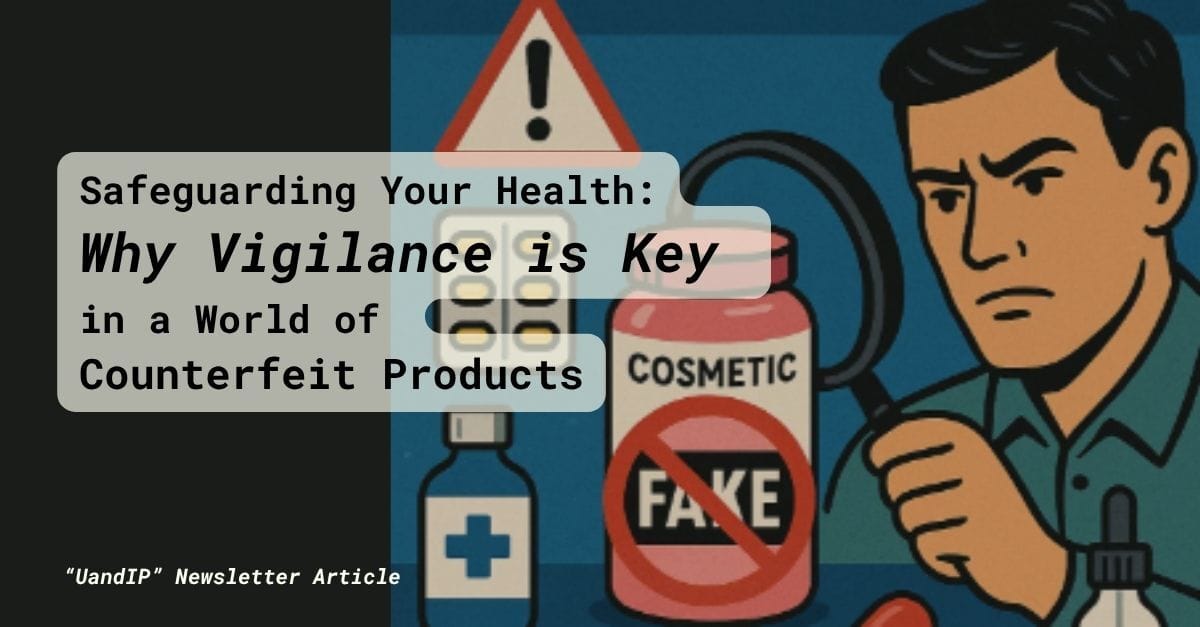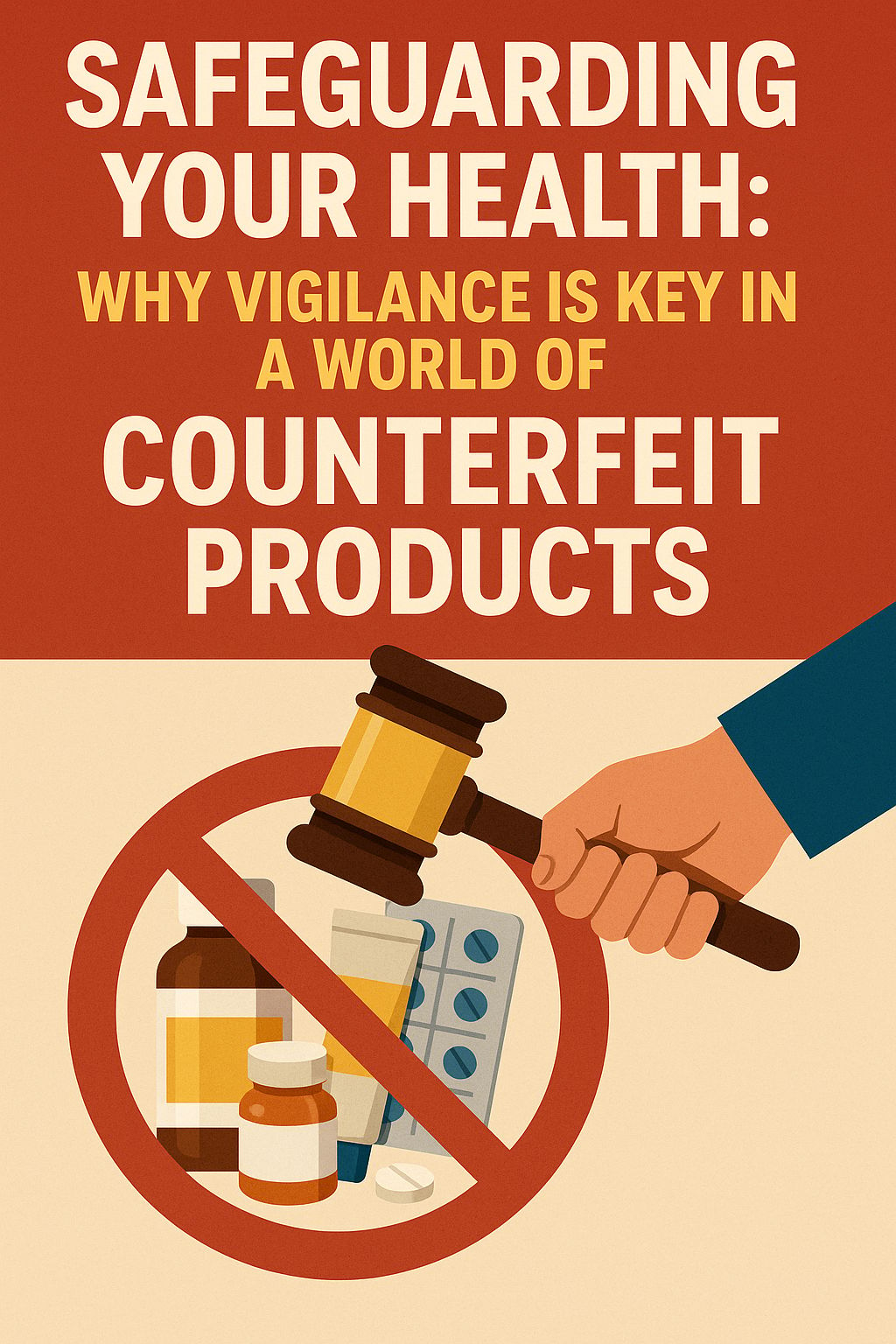- UandIP
- Posts
- Safeguarding Your Health: Why Vigilance is Key in a World of Counterfeit Products
Safeguarding Your Health: Why Vigilance is Key in a World of Counterfeit Products

Just recently, while casually browsing an e-commerce platform for cosmetic products – an everyday activity for many of us – a familiar professional instinct took over. I found myself automatically cross-referencing products with the Philippine Food and Drug Administration (FDA) advisories and the Intellectual Property Office of the Philippines (IPOPHL) records, almost a mechanical memory, to check for authenticity, safety, and registered trademarks.
This routine check quickly reminded me of a critical issue I've addressed:
the pervasive threat of substandard and falsified medical products, equipment, and apparatus.
This isn't merely about pharmaceuticals; it extends to a wide array of items, including the cosmetics I was browsing. The stark reality is that consumers and players across the entire supply chain, from manufacturing to retail, must observe utmost caution. This newsletter aims to reiterate the gravity of this situation and, importantly, to highlight the indispensable role and profound responsibilities of IP professionals in this ongoing, critical battle.
The Intensifying Crisis of Substandard and Falsified Products
The battle against substandard and falsified medical products continues to intensify across the Philippines and globally, demanding renewed attention from all stakeholders. Recent data from the World Health Organization (WHO) confirms that at least one in ten medical products in low- and middle-income countries (LMICs), such as the Philippines, are substandard or falsified. The Philippines faces significant challenges in this arena, with the Philippine FDA identifying 151 counterfeit products in 2023 alone, which included 116 over-the-counter medicines, 31 prescription drugs, and 4 home remedy products. The most commonly counterfeited medications remain familiar names: Biogesic, Decolgen Forte, Bioflu, Alaxan FR, and Diatabs.
The economic impact of these illicit products is staggering, with countries globally spending an estimated US$30.5 billion annually on them. In the Philippines, "Oplan Katharos," the FDA's comprehensive detection and seizure initiative launched in November 2023, had already intercepted approximately ₱28 million worth of counterfeit medicines and health devices as of September 2024. However, this figure is acknowledged as "only the tip of the iceberg" in terms of the actual volume of dangerous products circulating in the market.
The Cosmetics Conundrum: An Expanding Threat
The concern isn't limited to traditional pharmaceuticals. The threat has significantly expanded to include cosmetic products, which have become increasingly targeted by counterfeiters. Recent FDA advisories have specifically warned against unauthorized cosmetic products such as "Best Beauty" and "Rain by Colortrends Ice Pop," highlighting the potential for severe health risks. These risks include skin irritation, anaphylactic shock, and even organ failure due to contamination or adulteration.
Recognizing this growing danger, the Chamber of Cosmetics Industry of the Philippines (CCIP) joined IPOPHL's E-Commerce Memorandum of Understanding (MOU) in March 2025, alongside 18 member companies. This collaborative approach acknowledges that while e-commerce platforms facilitate broader market access, they simultaneously create new avenues for the distribution of counterfeit and substandard products, posing a direct threat to consumer safety.

Image generated using chatgpt.com.
The Critical Role of Intellectual Property Professionals
In this increasingly complex landscape, intellectual property professionals serve as frontline defenders in the battle against falsified and substandard medical products, equipment, and apparatus. Our responsibilities extend far beyond the traditional scope of registration and enforcement activities, encompassing a proactive and collaborative approach:
Proactive Monitoring and Intelligence Gathering
We must maintain vigilant surveillance of market activities, including monitoring e-commerce platforms, analyzing trademark applications for suspicious similarities, and coordinating with brand owners to identify emerging threats before they gain significant market penetration. This involves identifying potential infringement patterns and counterfeit operations early on.
Cross-Agency Collaboration
The fight against counterfeits demands a multi-agency approach. IP professionals are crucial bridges between IPOPHL, the FDA, the Philippine National Police (PNP), and other enforcement agencies. The National Committee on Intellectual Property Rights (NCIPR), comprising 15 government agencies, provides a framework for this coordination, but its effective implementation depends on professionals who understand both IP law and public health implications.
Consumer Education and Awareness
Research consistently shows critically low awareness of substandard and falsified medicines among both the general public and healthcare professionals. Studies indicate that only 24% of the public and 35% of healthcare professionals report familiarity with these issues, and only 30.6% of consumers can correctly identify counterfeit medications, highlighting an urgent need for targeted training programs.
IP professionals must actively contribute to educational initiatives that empower consumers with practical identification skills to identify and report suspicious products. This also extends to fostering digital literacy and online safety, teaching consumers how to evaluate legitimate online vendors, recognize fraudulent websites, and use official verification tools such as the FDA's verification portal at verification.fda.gov.ph.
Technological Innovation and Adaptation
Counterfeiting operations are undergoing digital transformation, requiring IP professionals to understand and leverage emerging technologies. This includes familiarity with blockchain authentication systems, AI-powered monitoring tools, and sophisticated online enforcement mechanisms.
Enhanced Professional Standards
IPOPHL's recent implementation of mandatory accreditation for patent and trademark agents through Memorandum Circulars 2024-012 and 2024-013 establishes formal recognition systems requiring training, qualification examinations, and ongoing professional development. This is vital to ensure all recognized professionals understand their pivotal role in protecting consumer safety.
Broader Strategies and Our Collective Responsibility
The efforts of IP professionals are part of a larger strategic framework aimed at enhancing public health protection. This includes:
Streamlined Regulatory Processes with Digital Integration
The need for improved procedural efficiency remains paramount. Current processing timelines for pharmaceutical approvals continue to pose significant challenges; Certificates of Product Registration (CPR) can take from 8 months to a maximum of 2 to 4 years, and Certificates of Listing of Identical Drug Product (CLIDP) require 3 months to a maximum of 1 year.
The integration of digital technologies, including blockchain-based tracking systems and AI-powered authentication tools, offers promising solutions for reducing these processing times while enhancing security. DOH-FDA-PDEA cooperation is essential to outline implementing steps for streamlining regulatory procedures and improving the timeframe for assessing and evaluating compliance requirements.
Enhanced Detection and Elimination Systems
This strategic pillar has evolved significantly with technological advancement. Beyond the FDA's crucial verification portal at verification.fda.gov.ph, the Pharmaceutical Security Institute's partnership with IPOPHL has yielded valuable intelligence, indicating that the Philippines is more likely a transit point rather than a source of counterfeit medicines. This distinction is crucial for developing targeted enforcement strategies and international cooperation frameworks.
There is a need for an upgraded joint task force composed of the DOH, FDA, PDEA, DTI, PNP, IPOPHL, DepEd, and CHED to outline, improve, and implement systems including resources, materials, apparatus, and protocols. Funding for these methods may be supported by Republic Act 8203 or the Special Law on Counterfeit Drugs.
Scientific Mode of Detection
The usual method of determining substandard and falsified medical products (SFMPs) by laboratory analyses (DOST and private testing agencies) is time-consuming. It is apparent that there should be increased availability of devices, such as drug composition scanners and detectors, in healthcare institutions, hospitals, pharmacies, local government units and agencies, and the PNP.
Strengthened Intellectual Property, Legal Affairs, and Law Enforcement
Although IPOPHL and FDA are separate entities, there is a clear overlap concerning the pharmaceutical industry. Any interplay arising from unlawful health practices and the distribution of SFMPs should be easily communicated and reported through a channel accessible to all relevant agencies.
Comprehensive Public and Professional Awareness Campaigns
Building on successful models, educational programs should focus on practical identification skills. Healthcare professionals require enhanced training on recognizing and reporting SFMPs; current data indicates significant gaps, with 68.5% of community pharmacists having no experience identifying SFMPs, representing a critical vulnerability. This also includes:
School-relevant activities
Incorporating the campaign in educational curricula for both public and private schools under DepEd, science high schools under DOST, and state universities and colleges under CHED.
Trade-relevant activities
Briefing personnel involved in sale, distribution, consignment, and licensing.
Mass media-relevant strategies
Implementing a developmental communication approach for improved information dissemination to all Philippine stakeholders and constituents.
Recommendations for Enhanced Implementation
Integrated Technology Platform Development
Establish a unified digital platform connecting FDA verification systems, IPOPHL trademark databases, and consumer reporting mechanisms to enable real-time authentication and streamlined enforcement.
Regional Cooperation Framework
Strengthen collaboration with ASEAN partners and international organizations to address cross-border trafficking of counterfeit products, especially given the Philippines' role as a transit point.
Private Sector Partnership Expansion
Build upon successful initiatives like the E-Commerce MOU to include broader industry participation beyond cosmetics and pharmaceuticals.
Data-Driven Monitoring Systems
Implement comprehensive data collection and analysis systems to track the effectiveness of enforcement actions and identify emerging trends in counterfeit operations.
The fight against substandard and falsified medical products requires unwavering commitment from all stakeholders. This includes the Departments of Health (DOH), Science and Technology (DOST), Trade and Industry (DTI), and Education (DepEd); the Philippine FDA; IPOPHL; the Philippine Drug Enforcement Agency (PDEA) and the Dangerous Drugs Board (DDB); the Commission on Higher Education (CHED); and the Philippine National Police (PNP). It also involves the private sector and, most importantly, consumers.
Our success will be measured not just by the number of counterfeit products seized, but by the lives protected through prevention of exposure to dangerous products. As IP professionals, every patent filed, trademark registered, and enforcement action initiated represents a contribution to the broader mission of safeguarding public health.
The strategies outlined, building upon previous foundations while addressing current challenges, provide a roadmap for enhanced protection. However, their effectiveness depends on the collective commitment of IP professionals, regulatory agencies, healthcare providers, and consumers working together toward the common goal of ensuring that only safe, effective, and authentic medical products reach Filipino consumers.
The battle continues, but with strengthened partnerships, enhanced technologies, and renewed commitment to professional excellence, we can build a more secure healthcare environment for all Filipinos.
The responsibility rests with each of us to remain vigilant, informed, and committed to this essential mission of protecting public health through robust intellectual property protection and enforcement.
IP professionals are encouraged to stay informed about regulatory updates and to actively participate in collaborative enforcement efforts through official channels such as IPOPHL's reporting systems and professional development programs.
#2025July
BTW… I wrote a book! It’s"UandIP for MSMEs," a starter kit for individual creators and inventors/innovators, new businesses, and existing micro, small, and medium, enterprises (MSMEs) to help make Intellectual Property (IP) become accessible and easy to navigate --- not intimidating, but rather inviting. This is good for those who would like to learn the basics of intellectual property to help them get started and focus on the important aspects of their business. It hopes this IP knowledge-sharing method is one step away from achieving inclusive IP awareness and education for ALL as A book FROM AN MSME FOR FELLOW MSMEs!
It is specifically designed to make the world of intellectual property accessible and actionable for small and medium-sized businesses.
Get your copy today by sending an email to [email protected].
Let's unlock the potential of your intellectual assets together!
#2025July07
*Generated Images: sora.chatgpt.com (Thumbnail), chatgpt.com (In-Article)
Created and Written by Alexandra Palacpac, U&IP 2025.
NOTE: By clicking this link, I may have a small compensation at absolutely NO COST TO YOU.
Hope you enjoy writing with BEEHIIV as I do.
Reply